Hong Kong Tramways
 | |||||||||||||||||||||||||||||||||||||||||||||||||||||||||||||||||||||||||||||||||||||||||||||||||||||||||||||||||||||||||||||||||||||||||||||||||||||||||||||||||||||||||||||||||||||||||||||||||||||||||||||||||||||||||||||||||||||||||||||||||||||||||||||||||||||||||||||||||||||||||||||||||||||||||||||||||||||||||||||||||||||||||||||||||||||||||||||||||||||||||||||||||||||||||||||||||||||||||||||||||||||||||||||||||||||||||||||||||||||||||||||||||||||||||||||||||||||||||||||||||||||||||||||||||||||||||||||||||||||||||||||||||||||||||||||||||||||||||||||||||||||||||||||||||||||||||||||||||||||||||||||||||||||||||||||||||||||||||||||||||||||||||||||||||||||||||||||||
 A typical HKT double-decker tram | |||||||||||||||||||||||||||||||||||||||||||||||||||||||||||||||||||||||||||||||||||||||||||||||||||||||||||||||||||||||||||||||||||||||||||||||||||||||||||||||||||||||||||||||||||||||||||||||||||||||||||||||||||||||||||||||||||||||||||||||||||||||||||||||||||||||||||||||||||||||||||||||||||||||||||||||||||||||||||||||||||||||||||||||||||||||||||||||||||||||||||||||||||||||||||||||||||||||||||||||||||||||||||||||||||||||||||||||||||||||||||||||||||||||||||||||||||||||||||||||||||||||||||||||||||||||||||||||||||||||||||||||||||||||||||||||||||||||||||||||||||||||||||||||||||||||||||||||||||||||||||||||||||||||||||||||||||||||||||||||||||||||||||||||||||||||||||||||
| Overview | |||||||||||||||||||||||||||||||||||||||||||||||||||||||||||||||||||||||||||||||||||||||||||||||||||||||||||||||||||||||||||||||||||||||||||||||||||||||||||||||||||||||||||||||||||||||||||||||||||||||||||||||||||||||||||||||||||||||||||||||||||||||||||||||||||||||||||||||||||||||||||||||||||||||||||||||||||||||||||||||||||||||||||||||||||||||||||||||||||||||||||||||||||||||||||||||||||||||||||||||||||||||||||||||||||||||||||||||||||||||||||||||||||||||||||||||||||||||||||||||||||||||||||||||||||||||||||||||||||||||||||||||||||||||||||||||||||||||||||||||||||||||||||||||||||||||||||||||||||||||||||||||||||||||||||||||||||||||||||||||||||||||||||||||||||||||||||||||
|---|---|---|---|---|---|---|---|---|---|---|---|---|---|---|---|---|---|---|---|---|---|---|---|---|---|---|---|---|---|---|---|---|---|---|---|---|---|---|---|---|---|---|---|---|---|---|---|---|---|---|---|---|---|---|---|---|---|---|---|---|---|---|---|---|---|---|---|---|---|---|---|---|---|---|---|---|---|---|---|---|---|---|---|---|---|---|---|---|---|---|---|---|---|---|---|---|---|---|---|---|---|---|---|---|---|---|---|---|---|---|---|---|---|---|---|---|---|---|---|---|---|---|---|---|---|---|---|---|---|---|---|---|---|---|---|---|---|---|---|---|---|---|---|---|---|---|---|---|---|---|---|---|---|---|---|---|---|---|---|---|---|---|---|---|---|---|---|---|---|---|---|---|---|---|---|---|---|---|---|---|---|---|---|---|---|---|---|---|---|---|---|---|---|---|---|---|---|---|---|---|---|---|---|---|---|---|---|---|---|---|---|---|---|---|---|---|---|---|---|---|---|---|---|---|---|---|---|---|---|---|---|---|---|---|---|---|---|---|---|---|---|---|---|---|---|---|---|---|---|---|---|---|---|---|---|---|---|---|---|---|---|---|---|---|---|---|---|---|---|---|---|---|---|---|---|---|---|---|---|---|---|---|---|---|---|---|---|---|---|---|---|---|---|---|---|---|---|---|---|---|---|---|---|---|---|---|---|---|---|---|---|---|---|---|---|---|---|---|---|---|---|---|---|---|---|---|---|---|---|---|---|---|---|---|---|---|---|---|---|---|---|---|---|---|---|---|---|---|---|---|---|---|---|---|---|---|---|---|---|---|---|---|---|---|---|---|---|---|---|---|---|---|---|---|---|---|---|---|---|---|---|---|---|---|---|---|---|---|---|---|---|---|---|---|---|---|---|---|---|---|---|---|---|---|---|---|---|---|---|---|---|---|---|---|---|---|---|---|---|---|---|---|---|---|---|---|---|---|---|---|---|---|---|---|---|---|---|---|---|---|---|---|---|---|---|---|---|---|---|---|---|---|---|---|---|---|---|---|---|---|---|---|---|---|---|---|---|---|---|---|---|---|---|---|---|---|---|---|---|---|---|---|---|---|---|---|---|---|---|---|---|---|---|---|---|---|---|---|---|---|---|---|---|---|---|---|---|---|---|---|---|---|---|---|---|---|---|---|---|---|---|---|---|---|---|---|---|---|---|---|---|---|---|---|---|---|---|---|---|---|---|---|---|---|---|---|---|---|---|---|---|---|---|---|---|---|---|---|---|---|---|---|---|---|---|---|---|---|---|---|---|---|---|---|---|---|---|---|---|---|---|---|---|---|---|---|---|---|---|---|---|---|---|---|---|---|---|---|---|---|---|---|---|---|---|---|---|---|---|---|---|---|---|---|---|---|---|---|---|---|---|---|---|---|---|---|---|---|---|---|---|---|---|---|---|---|---|---|---|---|---|---|---|---|---|---|---|---|---|---|---|---|---|---|---|---|---|---|---|---|---|---|---|---|---|---|---|---|---|---|---|
| Locale | |||||||||||||||||||||||||||||||||||||||||||||||||||||||||||||||||||||||||||||||||||||||||||||||||||||||||||||||||||||||||||||||||||||||||||||||||||||||||||||||||||||||||||||||||||||||||||||||||||||||||||||||||||||||||||||||||||||||||||||||||||||||||||||||||||||||||||||||||||||||||||||||||||||||||||||||||||||||||||||||||||||||||||||||||||||||||||||||||||||||||||||||||||||||||||||||||||||||||||||||||||||||||||||||||||||||||||||||||||||||||||||||||||||||||||||||||||||||||||||||||||||||||||||||||||||||||||||||||||||||||||||||||||||||||||||||||||||||||||||||||||||||||||||||||||||||||||||||||||||||||||||||||||||||||||||||||||||||||||||||||||||||||||||||||||||||||||||||
| Transit type | Tramway | ||||||||||||||||||||||||||||||||||||||||||||||||||||||||||||||||||||||||||||||||||||||||||||||||||||||||||||||||||||||||||||||||||||||||||||||||||||||||||||||||||||||||||||||||||||||||||||||||||||||||||||||||||||||||||||||||||||||||||||||||||||||||||||||||||||||||||||||||||||||||||||||||||||||||||||||||||||||||||||||||||||||||||||||||||||||||||||||||||||||||||||||||||||||||||||||||||||||||||||||||||||||||||||||||||||||||||||||||||||||||||||||||||||||||||||||||||||||||||||||||||||||||||||||||||||||||||||||||||||||||||||||||||||||||||||||||||||||||||||||||||||||||||||||||||||||||||||||||||||||||||||||||||||||||||||||||||||||||||||||||||||||||||||||||||||||||||||||
| Number of lines | 1 | ||||||||||||||||||||||||||||||||||||||||||||||||||||||||||||||||||||||||||||||||||||||||||||||||||||||||||||||||||||||||||||||||||||||||||||||||||||||||||||||||||||||||||||||||||||||||||||||||||||||||||||||||||||||||||||||||||||||||||||||||||||||||||||||||||||||||||||||||||||||||||||||||||||||||||||||||||||||||||||||||||||||||||||||||||||||||||||||||||||||||||||||||||||||||||||||||||||||||||||||||||||||||||||||||||||||||||||||||||||||||||||||||||||||||||||||||||||||||||||||||||||||||||||||||||||||||||||||||||||||||||||||||||||||||||||||||||||||||||||||||||||||||||||||||||||||||||||||||||||||||||||||||||||||||||||||||||||||||||||||||||||||||||||||||||||||||||||||
| Number of stations | 120 | ||||||||||||||||||||||||||||||||||||||||||||||||||||||||||||||||||||||||||||||||||||||||||||||||||||||||||||||||||||||||||||||||||||||||||||||||||||||||||||||||||||||||||||||||||||||||||||||||||||||||||||||||||||||||||||||||||||||||||||||||||||||||||||||||||||||||||||||||||||||||||||||||||||||||||||||||||||||||||||||||||||||||||||||||||||||||||||||||||||||||||||||||||||||||||||||||||||||||||||||||||||||||||||||||||||||||||||||||||||||||||||||||||||||||||||||||||||||||||||||||||||||||||||||||||||||||||||||||||||||||||||||||||||||||||||||||||||||||||||||||||||||||||||||||||||||||||||||||||||||||||||||||||||||||||||||||||||||||||||||||||||||||||||||||||||||||||||||
| Daily ridership | 180,000 (2015)[1] | ||||||||||||||||||||||||||||||||||||||||||||||||||||||||||||||||||||||||||||||||||||||||||||||||||||||||||||||||||||||||||||||||||||||||||||||||||||||||||||||||||||||||||||||||||||||||||||||||||||||||||||||||||||||||||||||||||||||||||||||||||||||||||||||||||||||||||||||||||||||||||||||||||||||||||||||||||||||||||||||||||||||||||||||||||||||||||||||||||||||||||||||||||||||||||||||||||||||||||||||||||||||||||||||||||||||||||||||||||||||||||||||||||||||||||||||||||||||||||||||||||||||||||||||||||||||||||||||||||||||||||||||||||||||||||||||||||||||||||||||||||||||||||||||||||||||||||||||||||||||||||||||||||||||||||||||||||||||||||||||||||||||||||||||||||||||||||||||
| Website | hktramways | ||||||||||||||||||||||||||||||||||||||||||||||||||||||||||||||||||||||||||||||||||||||||||||||||||||||||||||||||||||||||||||||||||||||||||||||||||||||||||||||||||||||||||||||||||||||||||||||||||||||||||||||||||||||||||||||||||||||||||||||||||||||||||||||||||||||||||||||||||||||||||||||||||||||||||||||||||||||||||||||||||||||||||||||||||||||||||||||||||||||||||||||||||||||||||||||||||||||||||||||||||||||||||||||||||||||||||||||||||||||||||||||||||||||||||||||||||||||||||||||||||||||||||||||||||||||||||||||||||||||||||||||||||||||||||||||||||||||||||||||||||||||||||||||||||||||||||||||||||||||||||||||||||||||||||||||||||||||||||||||||||||||||||||||||||||||||||||||
| Operation | |||||||||||||||||||||||||||||||||||||||||||||||||||||||||||||||||||||||||||||||||||||||||||||||||||||||||||||||||||||||||||||||||||||||||||||||||||||||||||||||||||||||||||||||||||||||||||||||||||||||||||||||||||||||||||||||||||||||||||||||||||||||||||||||||||||||||||||||||||||||||||||||||||||||||||||||||||||||||||||||||||||||||||||||||||||||||||||||||||||||||||||||||||||||||||||||||||||||||||||||||||||||||||||||||||||||||||||||||||||||||||||||||||||||||||||||||||||||||||||||||||||||||||||||||||||||||||||||||||||||||||||||||||||||||||||||||||||||||||||||||||||||||||||||||||||||||||||||||||||||||||||||||||||||||||||||||||||||||||||||||||||||||||||||||||||||||||||||
| Began operation | 1904 | ||||||||||||||||||||||||||||||||||||||||||||||||||||||||||||||||||||||||||||||||||||||||||||||||||||||||||||||||||||||||||||||||||||||||||||||||||||||||||||||||||||||||||||||||||||||||||||||||||||||||||||||||||||||||||||||||||||||||||||||||||||||||||||||||||||||||||||||||||||||||||||||||||||||||||||||||||||||||||||||||||||||||||||||||||||||||||||||||||||||||||||||||||||||||||||||||||||||||||||||||||||||||||||||||||||||||||||||||||||||||||||||||||||||||||||||||||||||||||||||||||||||||||||||||||||||||||||||||||||||||||||||||||||||||||||||||||||||||||||||||||||||||||||||||||||||||||||||||||||||||||||||||||||||||||||||||||||||||||||||||||||||||||||||||||||||||||||||
| Operator(s) | RATP Dev Transdev Asia | ||||||||||||||||||||||||||||||||||||||||||||||||||||||||||||||||||||||||||||||||||||||||||||||||||||||||||||||||||||||||||||||||||||||||||||||||||||||||||||||||||||||||||||||||||||||||||||||||||||||||||||||||||||||||||||||||||||||||||||||||||||||||||||||||||||||||||||||||||||||||||||||||||||||||||||||||||||||||||||||||||||||||||||||||||||||||||||||||||||||||||||||||||||||||||||||||||||||||||||||||||||||||||||||||||||||||||||||||||||||||||||||||||||||||||||||||||||||||||||||||||||||||||||||||||||||||||||||||||||||||||||||||||||||||||||||||||||||||||||||||||||||||||||||||||||||||||||||||||||||||||||||||||||||||||||||||||||||||||||||||||||||||||||||||||||||||||||||
| Number of vehicles | 165[2] | ||||||||||||||||||||||||||||||||||||||||||||||||||||||||||||||||||||||||||||||||||||||||||||||||||||||||||||||||||||||||||||||||||||||||||||||||||||||||||||||||||||||||||||||||||||||||||||||||||||||||||||||||||||||||||||||||||||||||||||||||||||||||||||||||||||||||||||||||||||||||||||||||||||||||||||||||||||||||||||||||||||||||||||||||||||||||||||||||||||||||||||||||||||||||||||||||||||||||||||||||||||||||||||||||||||||||||||||||||||||||||||||||||||||||||||||||||||||||||||||||||||||||||||||||||||||||||||||||||||||||||||||||||||||||||||||||||||||||||||||||||||||||||||||||||||||||||||||||||||||||||||||||||||||||||||||||||||||||||||||||||||||||||||||||||||||||||||||
| Technical | |||||||||||||||||||||||||||||||||||||||||||||||||||||||||||||||||||||||||||||||||||||||||||||||||||||||||||||||||||||||||||||||||||||||||||||||||||||||||||||||||||||||||||||||||||||||||||||||||||||||||||||||||||||||||||||||||||||||||||||||||||||||||||||||||||||||||||||||||||||||||||||||||||||||||||||||||||||||||||||||||||||||||||||||||||||||||||||||||||||||||||||||||||||||||||||||||||||||||||||||||||||||||||||||||||||||||||||||||||||||||||||||||||||||||||||||||||||||||||||||||||||||||||||||||||||||||||||||||||||||||||||||||||||||||||||||||||||||||||||||||||||||||||||||||||||||||||||||||||||||||||||||||||||||||||||||||||||||||||||||||||||||||||||||||||||||||||||||
| System length | Mainline: 13.3 kilometres (8.3 mi)
Happy Valley Loop: 2.6 kilometres (1.6 mi) Total Track Length: 30 kilometres (19 mi) | ||||||||||||||||||||||||||||||||||||||||||||||||||||||||||||||||||||||||||||||||||||||||||||||||||||||||||||||||||||||||||||||||||||||||||||||||||||||||||||||||||||||||||||||||||||||||||||||||||||||||||||||||||||||||||||||||||||||||||||||||||||||||||||||||||||||||||||||||||||||||||||||||||||||||||||||||||||||||||||||||||||||||||||||||||||||||||||||||||||||||||||||||||||||||||||||||||||||||||||||||||||||||||||||||||||||||||||||||||||||||||||||||||||||||||||||||||||||||||||||||||||||||||||||||||||||||||||||||||||||||||||||||||||||||||||||||||||||||||||||||||||||||||||||||||||||||||||||||||||||||||||||||||||||||||||||||||||||||||||||||||||||||||||||||||||||||||||||
| Track gauge | 1,067 mm (3 ft 6 in) | ||||||||||||||||||||||||||||||||||||||||||||||||||||||||||||||||||||||||||||||||||||||||||||||||||||||||||||||||||||||||||||||||||||||||||||||||||||||||||||||||||||||||||||||||||||||||||||||||||||||||||||||||||||||||||||||||||||||||||||||||||||||||||||||||||||||||||||||||||||||||||||||||||||||||||||||||||||||||||||||||||||||||||||||||||||||||||||||||||||||||||||||||||||||||||||||||||||||||||||||||||||||||||||||||||||||||||||||||||||||||||||||||||||||||||||||||||||||||||||||||||||||||||||||||||||||||||||||||||||||||||||||||||||||||||||||||||||||||||||||||||||||||||||||||||||||||||||||||||||||||||||||||||||||||||||||||||||||||||||||||||||||||||||||||||||||||||||||
| Electrification | 550 V DC from overhead catenary | ||||||||||||||||||||||||||||||||||||||||||||||||||||||||||||||||||||||||||||||||||||||||||||||||||||||||||||||||||||||||||||||||||||||||||||||||||||||||||||||||||||||||||||||||||||||||||||||||||||||||||||||||||||||||||||||||||||||||||||||||||||||||||||||||||||||||||||||||||||||||||||||||||||||||||||||||||||||||||||||||||||||||||||||||||||||||||||||||||||||||||||||||||||||||||||||||||||||||||||||||||||||||||||||||||||||||||||||||||||||||||||||||||||||||||||||||||||||||||||||||||||||||||||||||||||||||||||||||||||||||||||||||||||||||||||||||||||||||||||||||||||||||||||||||||||||||||||||||||||||||||||||||||||||||||||||||||||||||||||||||||||||||||||||||||||||||||||||
| |||||||||||||||||||||||||||||||||||||||||||||||||||||||||||||||||||||||||||||||||||||||||||||||||||||||||||||||||||||||||||||||||||||||||||||||||||||||||||||||||||||||||||||||||||||||||||||||||||||||||||||||||||||||||||||||||||||||||||||||||||||||||||||||||||||||||||||||||||||||||||||||||||||||||||||||||||||||||||||||||||||||||||||||||||||||||||||||||||||||||||||||||||||||||||||||||||||||||||||||||||||||||||||||||||||||||||||||||||||||||||||||||||||||||||||||||||||||||||||||||||||||||||||||||||||||||||||||||||||||||||||||||||||||||||||||||||||||||||||||||||||||||||||||||||||||||||||||||||||||||||||||||||||||||||||||||||||||||||||||||||||||||||||||||||||||||||||||
Hong Kong Tramways (HKT) is a 3 ft 6 in (1,067 mm) narrow-gauge tram[3] system in Hong Kong. Owned and operated by RATP Dev Transdev Asia, the tramway runs on Hong Kong Island between Kennedy Town and Shau Kei Wan, with a branch circulating through Happy Valley.
Hong Kong's tram system is one of the earliest forms of public transport in the metropolis, having opened in 1904 under British rule. It has used electric trams since its inauguration, and has never used horse or steam power. It owns the world's largest operational double-decker tram fleet, and is a very rare example of a tram system that uses them exclusively.[4] In addition to being used by commuters, the system is popular with tourists, and is one of the most environmentally friendly ways of travelling in the city.
History[]
Timeline[]

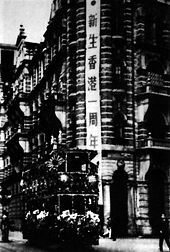

- 1881: Tramway system proposed for Hong Kong.
- 1882: The Hong Kong Government published the Professional Tramways Ordinance. However, the focus was on the Peak Tram, which was of more interest to the government and business interests that largely resided on Victoria Peak. As a result, there was little interest in developing the tram network along Hong Kong Island, so the policy was deferred.[5]
- 1883–1888: There was an increase in the population between 1883 and 1888, from 173,475 to 215,800.[6] The government hoped the tram system would give quick access to all areas of Victoria and reduce dependence on the chair coolies.[7]
- 1901: The government started to revise its tramway policy.[5] Tramway system proposal accepted by the government.
- 1902: Hong Kong Tramway Electric Company Limited founded in London.[8] Name changed to Electric Traction Company of Hong Kong Limited.
- 1903: Construction of a single-track system began from Kennedy Town to Causeway Bay; it was later extended to Shau Kei Wan.
- 1904: Bodies of first fleet of 26 UK-built tramcars shipped in pieces to Hung Hom to be assembled. The tramcars were all single-deck, and measured 8.8 metres (29 ft) long by 1.9 metres (6.2 ft) wide. 10 tramcars were designed for first class passengers and the others were for third class passengers. First-class compartments were enclosed in the centre and had two long benches on both sides, with both the front and back ends open. Seating capacity was 32 passengers. The third-class tramcars were open-sided, with six sets of benches running crossways back-to-back, seating 48 passengers. Fares for first and third class were ten cents and five cents respectively. The trams were initially going to be divided into three classes, but subsequently only first and third class were chosen for ease of operation.
- 1910: Company name changed to The Hong Kong Tramway Company Limited.
- 1912: First double-decker tramcar introduced in 1912 due to strong passenger demand. The tramcar had an open-balcony design, fitted with garden-type seats. The first class occupied the upper deck and one-third of the lower deck. Ten new tramcars constructed.
- 1922: Electricity contracted and supplied by Hong Kong Electric Company. Company name changed to Hong Kong Tramways Limited (HKT).
- 1925: Enclosed double-decker trams replaced open-balcony trams.
- 1932: North Point Depot came into service.
- 1934: Refuge islands began to be introduced at some busy tram stops to increase passenger safety.
- 1941: Japanese occupation begins. Very limited service was provided; only 12 tramcars were in operation daily from Causeway Bay to Sheung Wan. One single-decker tram was used for freight transport.
- 1945: After three years and eight months of Japanese occupation, all 109 tramcars remained, but only 15 were operational. By October 1945, 40 tramcars were back in service.
- 1949: Single-track system replaced by double-track system in August.
- 1950: HKT undertook an extensive redesign and started building its own trams. Tram bodies adopted a "modern" design.
- 1954: North Point Depot closed and Russell Street Depot expanded and renamed Sharp Street East Depot.
- 1964: Three locally made trams added, including the first single-deck trailer.
- 1965: 10 single-deck trailers introduced. Trailers were attached to the backs of tramcars and designed to serve first class passengers only. Seating capacity was 36 passengers.
- 1966: 22 single-deck trailers deployed during 1966–67. Trailers were withdrawn from service by 1982 due to frequent derailments and being uneconomical to run; they each required a separate conductor.
- 1967: Last trailer built by HKT.
- 1972: Class distinction abolished and flat fare introduced.
- 1974: HKT acquired by The Wharf (Holdings)
- 1976: Coin fareboxes installed at each tram front exit, and rotating turnstiles fitted at each tram rear entrance. Conductors were no longer needed and most of them retrained to become motormen.
- 1986: Tram refurbishment began.
- 1989: Sharp Street East Depot closed and depot functions split between Whitty Street Depot and Sai Wan Ho Depot.
- 1992: Two HKT-built double-decker tramcars exported to the Wirral Tramway in Birkenhead, England. Point automation system deployed, and manual point operation abolished.
- 2000: Coloured destination blinds began. HKT launches new "Millennium" trams designed and manufactured by its own engineering team on 24 October.
- 2001: Octopus electronic smart card payment system introduced on trams.
- 2004: HKT celebrates 100 years of service.
- 2007: Route maps reinstalled at each tram stop. New tram driving panels introduced on 7 November.
- 2008: Air conditioning installed on antique-style tramcar No. 128.
- 2009: 50% stake and operating rights obtained by Veolia Transport RATP Asia (now RATP Dev Transdev Asia), followed by full ownership in 2010.[8]
- 2011: HKT launches seventh-generation trams on 28 November 2011. It has a combination of a modern interior design and a traditional tram body exterior.
- 2014: HKT celebrates 110 years of service.
- 2015: Following the opening of the West Island line of the MTR, daily tramway ridership drops 10% to 180,000.[1]
- 2016: HKT gives real-time estimated time of arrival data to Citymapper, becoming the first transport operator in Hong Kong to do so.[9]
- 2017: Rebrand with new logo, new livery, and new map.[10]
Ownership[]
- Hong Kong Tramway Electric Company Limited, 1904–1974
- The Wharf (Holdings), Limited 1974–2009; retained 50% stake from 2009 to 2010
- RATP Dev Transdev Asia, 2010–present
- Kennedy Town, Shek Tong Tsui, Sai Ying Pun, Sheung Wan, Central, Admiralty, Wan Chai, Happy Valley, Causeway Bay, Tin Hau, North Point, Quarry Bay, Sai Wan Ho, Shau Kei Wan
Practical information[]
- Fare – $2.60[11]
- Operating hours – 5:30 am to 12:30 am
- Total length – 13 kilometres (8.1 mi) (Track length 30 kilometres (19 mi))
On average, the headway between each tram departure is approximately 1.5 minutes during peak hours. The maximum capacity of each tram is 115 people. Previously, the average tram speed was around 30 kilometres per hour (19 mph). Since early 2008, the speed of the trams was increased. The tram's general speed is currently around 40 kilometres per hour (25 mph). Most of the trams have a maximum speed of more than 50 kilometres per hour (31 mph), while some have a maximum speed of 60 kilometres per hour (37 mph). Hong Kong people informally call the tramway the "Ding Ding" (叮叮), in reference to the double-bell ring used by the trams to warn pedestrians of their approach.[12] Relative to buses and the subway system, trams are often the cheapest public transportation option. [13] [14]
Tickets[]
As of 2 July 2018, HKT fares are $2.60 for adults, $1.30 for children, and $1.20 for senior citizens.[11] Unlike most forms of public transport in Hong Kong, HKT fares are uniform regardless of the distance travelled.[15] Monthly tickets costing $200 are sold at the Shek Tong Tsui, Causeway Bay, and North Point termini at the end of each month.
Passengers pay upon alighting by either depositing the exact fare in coins into the farebox, or by using an Octopus card.[15] Turnstiles at the tram entrances and closed circuit television prevent fare evasion by passengers.
Tourist services[]

Sightseeing tours are available on antique-style tramcar No. 68, which has an open balcony and a historical exhibit on board. Sightseeing tram boarding and alighting take place at the sightseeing tour termini: Western Market and Causeway Bay.
Standard tramcars and antique-style, open-balcony tramcars No. 18, No. 28, No. 68, and No. 128 are available for private charter.[2][15] Charter tram boarding and alighting take place at Whitty Street Depot, except for premium charter tramcar No. 18; its boarding and alighting takes place at Western Market Terminus.
Routes and stops[]

The trams run on a double-track tram line built parallel to the northern coastline of Hong Kong Island from Kennedy Town to Shau Kei Wan, with a single clockwise-running track of about 3 km (1.9 mi) around the Happy Valley Racecourse.
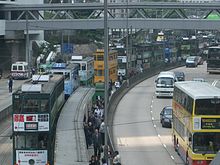
There are six overlapping routes:
- Kennedy Town ↔ Happy Valley
- Kennedy Town ↔ Shau Kei Wan
- Shek Tong Tsui ↔ Causeway Bay
- Shek Tong Tsui ↔ North Point
- Western Market ↔ Shau Kei Wan
- Happy Valley ↔ Shau Kei Wan
HKT currently has around 120 tram stops, including its seven termini. The termini, from west to east, are Kennedy Town, Shek Tong Tsui, Western Market, Happy Valley, Causeway Bay, North Point, and Shau Kei Wan.[16][17] The stops are densely located, with an average interval of 250 metres (820 ft) between them. Several tram stops are located in the middle of the road on sheltered refugee islands, which are accessed by pedestrian crossings or footbridges. Track crossovers near the Davis Street, Eastern Street, Pedder Street, Admiralty MTR station, Gresson Street, Victoria Park, North Point Road, and Mount Parker Road stops are used in emergency situations, such as en-route traffic accidents. The majority of HKT stops have remained unchanged since their establishment, but some have had name changes. The Pedder Street stop was previously named Shu Shun Kwun (書信館), which referred to a now-demolished former General Post Office building.
- Hong Kong Tramways termini
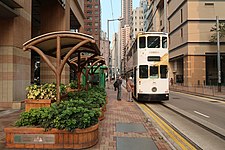
Kennedy Town Terminus
Shek Tong Tsui Terminus

Western Market Terminus

Happy Valley Terminus

Causeway Bay Terminus

North Point Terminus
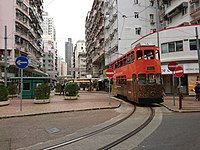
Shau Kei Wan Terminus
Interchanges[]

The Island line of the MTR is roughly parallel to the tram line between the Kennedy Town and Shau Kei Wan termini. Some sections of MTR tunnels are built directly under roads with tram tracks. Many HKT stops are in close proximity to MTR stations.[16][17]
Ferry terminals can be accessed from the tram line via footbridges, such as the Hong Kong–Macau Ferry Terminal and the Central Ferry Piers. The latter contains Star Ferry Pier, which is one of the stops for the Star Ferry.[16][17]
| Hong Kong Tramways | |||||||||||||||
|---|---|---|---|---|---|---|---|---|---|---|---|---|---|---|---|
| Traditional Chinese | 香港電車 | ||||||||||||||
| Simplified Chinese | 香港电车 | ||||||||||||||
| |||||||||||||||
Fleet[]
HKT has a rare fully double-decker tram fleet. As of 2014, HKT owned 165 double-axle, double-decker trams.[15] There are three maintenance-only trams (No. 200, No. 300, and No. 400) that operate after regular tram service has stopped. The trams are equipped with sliding windows and almost all have full-body advertisements.
| Make/model | Description | Fleet size | Year acquired | Year retired | Notes | Photographs |
| Dick, Kerr & Co of Preston, England (No. 1–16, No. 27–36), and Electric Railway & Tramway Works of Preston (a Dick Kerr subsidiary)
(No. 1–16) first batch of third class tramcars (No. 17–26) first class tramcars (No. 27–36) second batch of third class tramcars |
Single-deck tramcars – wood | 36 (reduced to 18 in 1912–1913, and further to 14 in 1923) | 1904–1905 | 1935 | ||
| United Electric Car Company of Preston, England, and Hong Kong & Whampoa Dock Co of Kowloon
(No. 37–46) first batch double-decker tramcars |
Double-decker trams – wood | 28 (10 as new, 18 rebuilt from single-deck tramcars) | 1912–1913 | 1924 (all were converted into fixed-roof trams) | Open balcony (fitted with canvas roof during bad weather) | |
| English Electric of Preston, England, and Hong Kong & Whampoa Dock Co of Kowloon
(No. 47–62) new-build canvas-roof tramcars (No. 63–80) fixed wood-roof tramcars |
Double-decker trams – wood | 48 (44 as new, 4 rebuilt from single-deck tramcars; canvas-roof tramcars also rebuilt with fixed wooden roof) | 1923–1924 | 1935 (pre–1920 bodies; others converted to fully enclosed tramcars) | First 16 new tramcars fitted with canvas roof; others fitted with fixed wooden roof | |
| HKT, Hong Kong - fully enclosed tramcars (prewar design) | Double-decker trams – wood | 119 (57 as new, 62 were rebuilt from existing fleet) | 1925–1949 | 1955 | 62 trams were converted from 14 single-deck trams and 48 canvas-roof and wood-roof trams | |
| HKT, Hong Kong - postwar tramcars (1949, 1950s design) | Double-decker trams – aluminium panels, teak frame | 163 (43 as new, 1 rebuilt in 1979 from non-powered trailer No. 1; others rebuilt from existing fleet) | 1949 (original No. 120), 1950–1964 (No. 121–162), 1979 (No. 163) | 1992 | 
| |
| HKT, Hong Kong - refurbished postwar tramcars, tramcars with 1987 design (current design) | Double-decker trams – aluminium panels, teak frame | 160 – No. 120 (rebuilt in 1990s based on 1950s design) and rest from the 1980s (No. 1–27, No. 29–43, No. 45–119, No. 121–127, No. 129–143, No. 145–163, No. 165–166) | Rebuilt from 1986, 1987–1992 | 1991 (refurbished postwar tramcars) | Tramcar No. 120 is distinguished by its green-coloured interior, teak-lined windows, and rattan seats. The interior of the No. 50 tramcar displayed at the Hong Kong Museum of History (different from the No. 50 tramcar currently in service) has a similar appearance. | 
|
| HKT, Hong Kong - Millennium | Double-decker trams – aluminium alloy | 4 (only 3 in service) – No. 168–171 | 2000 | Tramcar No. 171 was modified as an air-conditioned unit for internal testing; No. 168 and No. 171 rebuilt as VVVF drive vehicle | 
| |
| HKT, Hong Kong - trailer tramcars | Passenger single-deck tramcars – aluminium alloy, (No. 1 – aluminium panels, teak frame) | 22 | 1964, 1965–1966 | 1982 (except No. 1, which was rebuilt as double-decker tramcar No. 163) | Non-powered trailers | 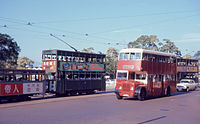
|
| HKT, Hong Kong - work tramcar | Single-deck tramcar | 1 – No. 200 (first generation) | 1956 | 1984 | ||
| HKT, Hong Kong - work tramcars | Double-decker trams | 3 – No. 200, No. 300, and No. 400 | Tramcar No. 300 runs on electricity and also a diesel motor | 
| ||
| HKT, Hong Kong - private hire tramcars | Antique-style double-decker trams – aluminium panels, teak frame | 2 – No. 28 and No. 128 (rebuilt from postwar tramcars No. 59 and No. 119) | 1985, 1987 | Private charter only | 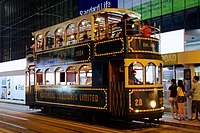
| |
| HKT, Hong Kong - first batch of VVVF drive vehicle | Double-decker trams – aluminium alloy, (No. 172 – aluminium panels, teak frame) | 56 – No. 1, No. 11–13, No. 19, No. 23, No. 32, No. 35–36, No. 40–42, No. 49, No. 52, No. 54, No. 56, No. 58, No. 60, No. 64, No. 66, No. 69–70, No. 74, No. 77, No. 79, No. 94–95, No. 99–100, No. 106, No. 108–109, No. 115–116, No. 118, No. 122, No. 126, No. 129, No. 132–133, No. 137, No. 141, No. 143, No. 146, No. 148, No. 154–155, No. 157–158, No. 162, No. 168, No. 171–175 | 2009–2016 | Exterior of body based on fourth-generation tramcars, but with Millennium tramcars interior, fitted with LED destination display | 
| |
| HKT, Hong Kong - sightseeing tramcar | Antique-style double-decker tram – aluminium alloy | 1 – No. 68 | 2016 | 1920s design; used for sightseeing tours | 
| |
| HKT, Hong Kong - first air-conditioned commuter vehicle "Pilot Cooler Tram" | Double-decker trams – aluminium alloy | 1 – No. 88 | 2016 | Three months trial service from 6 June 2016; first HKT commuter tram with air-conditioning installed[18] | 
| |
| HKT, Hong Kong, and Circus Limited, Hong Kong - premium private hire tramcar | Antique-style double-decker tram – aluminium alloy | 1 – No. 18 | 2018 | Amenities include three separate themed rooms, air conditioning, and an on-board restroom.[2] | 
|
Note: Generally, there are no specific/official generation categories on tramcars. Many of the trams in one generation were simply modifications of the previous, such as open-balcony tramcars fitted with canvas roofs and then wooden roofs. The term "generation" should only apply to the new designs.
Service fleet[]
- Mitsubishi Fuso Canter overhead cable maintenance vehicle No. 6016.[19]
- Temporary truck stand used for raising tram bodies and frames when trucks are removed for maintenance; it has small wheels that allow it to move around the depot.[20]
Depots[]
Current depots[]

Whitty Street Depot in Shek Tong Tsui is the main depot for current operations. It previously operated as a terminus. When the Sharp Street East Depot was closed, the site was expanded by 1.28 hectares (3.2 acres).[21] It has a two-storey workshop, which was responsible for rebuilds in the 1980s.
Sai Wan Ho Depot occupies a site of 0.7 hectares (1.7 acres) leased from the Hong Kong Government on a 5-year renewable tenancy.[21] It lies beneath the Island Eastern Corridor near Shau Kei Wan Road and Hoi Foo Street.[21] It can store 56 tramcars.
Defunct depots[]
A single, comprehensive depot at Russell Street in Causeway Bay was the only depot of the system in its early days. It was able to house the whole tram fleet (approximately 120 tramcars). By 1932, Russell Street Depot (also known as Causeway Bay Depot) became overcrowded due to an upsurge in the number of trams, prompting HKT to build North Point Depot at King's Road for tram parking purposes (storage for 30 tramcars). Russell Street Depot was later expanded and renamed Sharp Street East Depot. North Point Depot closed in 1951; its former location is now the site of the Healthy Gardens complex. In July 1986, the Executive Council approved the HKT plan to establish new depots at Shek Tong Shui and Sai Wan Ho. HKT claimed that $3.5 million in operating costs would be saved. HKT promised that fares would be unchanged until the end of 1988.[21] The Sharp Street East Depot was decommissioned in 1988 and closed in 1989. The site is now occupied by the Times Square complex.
Projects[]
Current projects[]
In 2010, HKT appointed a consultancy firm to investigate the feasibility of constructing a 12 kilometres (7.5 mi) modern tramway system in the Kai Tak Development, built on the vacated site of the former Kai Tak Airport, in place of the Environmentally Friendly Linkage System monorail proposed by the Hong Kong Government. A proposal was submitted to the Development Bureau on 29 April 2013.[22] HKT pointed out that the cost of constructing the proposed tram system is $2.8 billion, which is less than the $12 billion needed for a monorail system. Possible extensions to neighboring places such as To Kwa Wan, Kowloon City, and Kwun Tong were suggested. Bruno Charrade, Managing Director of HKT, said that the new system's tramcars could be designed to resemble their Hong Kong Island counterparts or have a totally new design, depending on the government's discretion.
Beginning in 2011, the entire HKT fleet will be refurbished over a period of seven years at a cost of $75 million. The trams will keep their original exterior design, but the outer teak structures will be replaced with aluminium structures. The benches on the lower decks of the trams will be replaced with modern-looking single seats. Digital broadcasts will be placed inside the trams to inform passengers of the next stop, and LED lighting will be installed. AC motors will replace the current DC motors and a new magnetic emergency braking system will be added.[23]
Abandoned projects[]
During the 1910s, Hong Kong Tramways proposed the Kowloon Tramways Project. However, the completion of KCR Railway caused the Hong Kong Government to veto the plan.[24]
In 1970, Chai Wan on the east side of Hong Kong Island was developed into a residential and industrial area, which greatly increased traffic demand to Central. Extending the tram line from Shau Kei Wan to Chai Wan was considered, but was ultimately rejected. This was due to low cost effectiveness associated with the need to tunnel through the hills between Shau Kei Wan and Chai Wan to maintain level track. The Island line of the MTR was built instead, and its first phase, between Chai Wan and Admiralty, opened on 31 May 1985.
During the development of Tuen Mun New Town in the 1970s, the government reserved space for the construction of a rail transportation system. In 1982, the government invited HKT to construct and operate a tram system in the area. HKT initially expressed interest in the construction of the railway and intended to operate it with double-decker trams, but later withdrew. The government then invited Kowloon-Canton Railway Corporation to construct and operate a light rail system. That system, now known as the Light Rail, opened to the public on 18 September 1988.[25]
April 2017 accident[]
During the early hours of Thursday, 6 April 2017, a tram tipped over in Central, injuring 14 people. Soon after, it was suggested that the tram was travelling too fast into a turn. The driver was later arrested for allegedly causing grievous bodily harm due to dangerous driving.[26] Two days later, it was reported that HKT suspended a speed monitoring programme intended to discourage drivers from travelling too slowly.[27]
See also[]
- Blackpool Tramway, also uses double-deck trams, but not exclusively
- Hong Kong Trams Station
- Trams in Alexandria, also uses double-deck trams, but not exclusively
- Trams in China
- Transport in Hong Kong
References[]
- ^ a b Sung, Timmy (4 March 2015). "Tram passengers down 10pc after opening of MTR West Island line". South China Morning Post. Retrieved 12 March 2015.
- ^ a b c "Hong Kong Tramways and Start-Up Circus Launch the Circus Tram – A Premium Party Tram (創新派對電車) Offering a Unique Ride to Experience Hong Kong Culture and Talents" (PDF). Hong Kong Tramways. 21 September 2018. Archived from the original (PDF) on 22 September 2018. Retrieved 22 September 2018.
- ^ DeWolf, Christopher (22 August 2016). "Rebuilding Hong Kong's 20p Time Machine". BBC Online. Archived from the original on 25 November 2017. Retrieved 17 August 2018.
- ^ "About HK Tramways".
- ^ a b Lee, C.L., 2015, ‘Hong Kong Tramways: a glimpse of its century’, Chung Hwa Book Co. (H.K.) Ltd.
- ^ Frederick Stewart, 1889, 'Report on the Blue Book and Departmental Reports for 1888', Colonial Secretary's Office. Retrieved from http://sunzi.lib.hku.hk/hkgro/view/s1889/1230.pdf
- ^ "The proposed new tramway to Victoria Gap". The Hong Kong Telegraph. 5 March 1904. p. 4.
- ^ a b A Snapshot of the Hong Kong Tramways Locomotives International issue 97 August 2015 pages 11-15
- ^ Boris Lee (29 March 2016). "首家交通應用程式獲電車實時資訊 Citymapper:政府應帶頭推動開放數據 (The first transport app receives real-time tram info Citymapper: government should make the lead for opening data)" (in Chinese). unwire. Retrieved 26 October 2017.
- ^ "Happy happy ding ding? New-look trams offer more smiles per mile". South China Morning Post. Retrieved 27 May 2017.
- ^ a b "電車7月2日起加價13% 成人加3毫每程$2.6" (in Chinese). 香港經濟日報. 29 May 2018.
- ^ Bland, Ben (30 June 2016). "Hong Kong trams struggle on journey to modernisation". Financial Times.
- ^ http://www.mtr.com.hk/ch/customer/images/promotion/qr_code_ticket/qr_code_ticket_leaflet.pdf
- ^ http://www.mtr.com.hk/archive/ch/pdf/2021_bus_leafet.pdf
- ^ a b c d Wong, Hiufu (26 March 2014). "How to Ride Hong Kong's Tram System". CNN. Retrieved 7 June 2016.
- ^ a b c "Eastbound Route Map" (PDF). Hong Kong Tramways. Archived from the original (PDF) on 24 August 2018. Retrieved 24 August 2018.
- ^ a b c "Westbound Route Map" (PDF). Hong Kong Tramways. Archived from the original (PDF) on 24 August 2018. Retrieved 24 August 2018.
- ^ Yeung, Raymond (2 June 2016). "Hong Kong tram operator offers air-conditioned car". South China Morning Post. Retrieved 7 June 2016.
- ^ "香港鐵路網".
- ^ "Archived copy". Archived from the original on 26 August 2018. Retrieved 22 December 2014.
{{cite web}}: CS1 maint: archived copy as title (link) - ^ a b c d Plan to relocate depot keeps tram-fares down, South China Morning Post, 16 July 1986
- ^ Fight for Modern Tramway at Kai Tak Hong Kong Facebook Page
- ^ Redesigning Hong Kong's iconic trams Railway Gazette International 14 October 2010
- ^ "University Museum and Art Gallery - The University of Hong Kong". www.umag.hku.hk. Retrieved 5 July 2019.
- ^ Hong Kong News Trolley Wire issue 235 November 1988 page 34
- ^ Ellie Ng, 06 April 2017, "Hong Kong tram driver arrested for alleged dangerous driving, as accident leaves 14 injured" at hongkongfp.com Accessed 8 April 2017
- ^ Peace Chiu and Nikki Sun, 08 April, 2017, "Hong Kong Tramways suspends slow driver warning programme in wake of Thursday's accident" at scmp.com/news Accessed 8 April 2017
Further reading[]
- Books
- R.L.P. Atkinson, A.K. Williams (1970). Hongkong Tramways: A history of Hongkong Tramways Limited, and predecessor companies. Light Railway Transport League. ISBN 978-090-04333-1-3.
- Barnett, Martin (1984). Tramlines: The Story of the Hong Kong Tramway System. South China Morning Post. ISBN 962-100-032-7.
- Davis, Mike (2004). Hong Kong Trams — Hong Kong Tramways 100 Years. ISBN 1-900515-95-4.
- Jones, Martin (1984). Tram Jam: The Hong Kong Tram Collection. Presstram. ISBN 962-711-801-X.
- Joseph, Tse; Lau, Ricky (2012). Amazing Ding Ding. ISBN 978-988-219-819-7.
- C.L., Lee (2015). Hong Kong Tramways: a glimpse of its century. Chung Hwa Book Co. (H.K.) Ltd.
- Lee, Eric (2012). A Centenary Date with Hong Kong Tramways. Tramric. ISBN 978-988-16655-0-8.
- Lee, Eric (2016). Hong Kong Tramways: Across the City, Across the Century. ISBN 978-988-83669-6-5.
- Liu, Bona; Lee, Eric; et al. (2013). Tram Art Gallery. Tramric. ISBN 978-988-16655-8-4.
- Joseph Tse Yiu-hon, John Prentice (2017). Hongkong Tramways: updating the original work of the late Peter Atkinson and Alan Williams. Light Rail Transport Association. ISBN 978-0-948106-48-4.
- WE LOVE TRAM. Hong Kong Tram Enthusiasts. 2011. ISBN 978-988-19956-4-3. Archived from the original on 4 November 2013.
- Websites
- DeWolf, Christopher (30 September 2013). "Rethinking Hong Kong's Trams". URBANPHOTO: Cities / People / Place. Retrieved 7 June 2016.
- Frederick Stewart. "Report on the Blue Book and Departmental Reports for 1888" (PDF). Colonial Secretary's Office. Retrieved 3 March 2019.
- Mullany, Gerry (14 October 2013). "Modern Subways Zip Below, but a City's Trams, Slow and Sweaty, Plod On". The New York Times. Retrieved 7 June 2016.
- "The proposed new tramway to Victoria Gap". Hong Kong Telegraph. Retrieved 3 March 2019.
External links[]
| Wikimedia Commons has media related to Hong Kong Tramways. |
Coordinates: 22°17′18″N 114°08′16″E / 22.2883°N 114.1377°E
- Hong Kong Tramways
- 3 ft 6 in gauge railways in Hong Kong
- 550 V DC railway electrification
- Companies formerly listed on the Hong Kong Stock Exchange
- Former companies in the Hang Seng Index
- Heritage railways in Hong Kong
- Hong Kong Island
- Railway companies of Hong Kong
- RATP Group
- Town tramway systems by city
- Tram transport in Hong Kong
- Tramways with double-decker trams
- Transdev
- Veolia







